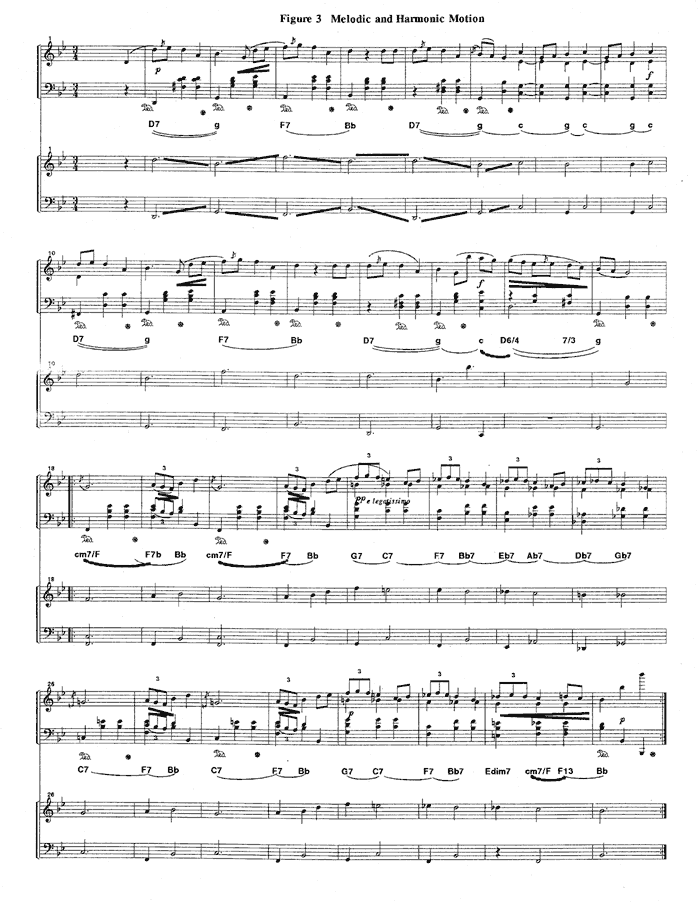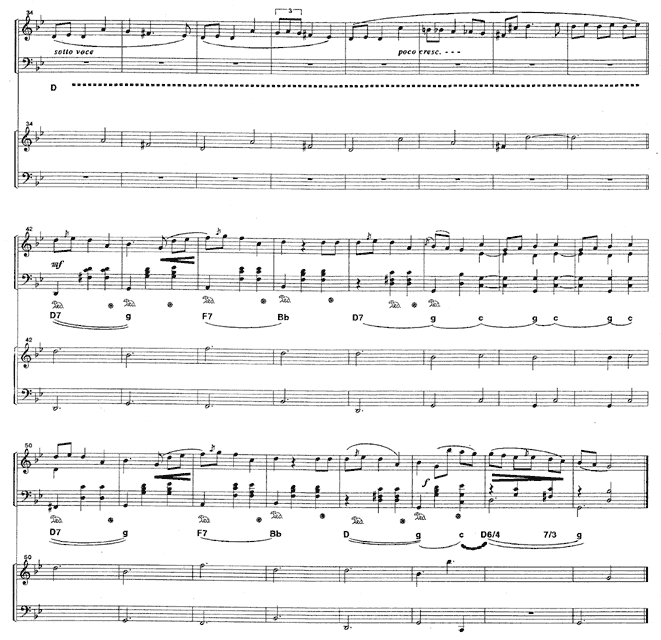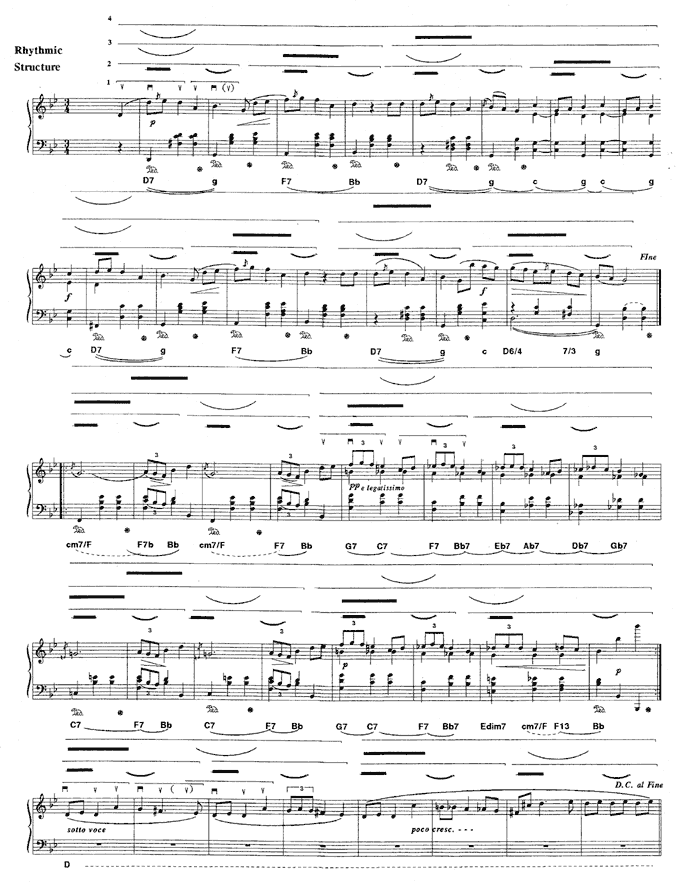
Musical Insights, Vol. 1 (Spring 1997) [Prev] [Next] [MACRO] [Journal Home] [Submissions]
In this essay I will present an extended macro analysis of Chopin's Mazurka, Op. 67 No. 2 as an illustration of how piano teachers might use insights from music theory and musicology to help the high-school or college piano student learn this piece and perform it musically. Since most students at this age are still learning how to play and how to analyze music, it is expected that the teacher would develop each of these ideas over a period of time in connection with the study and performance of many pieces.
The student should begin by experiencing the entire piece. This may be accomplished in several ways: through a recording; from the teacher's performance; by the teacher playing the upper staff while the student sight reads the lower staff, using the left hand for the single bass notes and the right hand for the two- and three-note sonorities in the tenor range.
In a first hearing at least four basic characteristics of this piece should be obvious, confirmed by inspection of the score. First, it is a tonally organized piano solo in a minor mode. Note that the final cadence is on G minor, with interior cadences on G minor (m. 16) and B-flat major (m. 32). Second, at the measure level it is in triple meter [34]. Third, these measures appear consistently grouped into at least four-measure units and some of the interior phrases given a cadential impression. (In a second hearing, while following the score, the eight measure phrase structure should become apparent.) Fourth, the texture consists primarily of a soprano melodic line supported by chords. The most common accompaniment pattern is a single bass note on the first beat of each measure followed by two- or three-tone sonorities in the tenor register on the second and third beats. One segment (phrase) consists of an unaccompanied melodic line.
Learning the technical aspects of the composition is simplified when identical and similar passages are identified. Awareness of melodic design reduces the total amount of material to be learned. The layout and graphics in figure 1 serve to display the phrase structure and the melodic and motivic designs of this piece.
Phrase Structure. Each system on the page contains one eight-measure phrase. Except for measures 33-40, these phrases are grouped into sixteen-measure sections. The phrases of the first and last sections are formatted to show their one
beat [ q ] anacrustic opening.
Melodic Design. At the section level, the design is ABCA' (or ABBCA' if the repeat of the second section is acknowledged). This design is indicated by the letters above the first, third, fifth, and sixth systems. At the four-measure level more similarities may be noted. Within the A and A' sections the design is ABA'C. Within the B section the design is ABAB'.
Motivic Design. As the teacher plays the melodic line alone, the student may listen for patterns that repeat, drawing faint circles around each pattern. On a second hearing the student could mark these circles, in the manner of figure 1, to show which patterns are related. This use of phrasing and dynamic shading should help the student pianist shape these musical ideas in performance. Further study of these motives may reveal to the perceptive student relationships between them such as those described below.
The first motive, a six-beat melodic shape in mm. 1-2 plus pickup is sequenced a third higher in mm. 3-4, with a variation on the pickup. It is repeated in mm. 5-6, with another variation on the pickup. The second motive follows immediately. Because it is half the length of the first, it is stated twice to complete the regular eight-measure phrase length, thereby giving AA'A''BB as the motivic design for this first phrase. The second phrase, except for the pitch of the pickup beat, begins exactly like the first phrase.
The third motive (mm. 17-18) introduces the first phrase of the B section and is promptly repeated. This motive may be heard as a variation of the second motive (mm. 6-8), given the metric prominence of these basic pitches: C-G-A-Bb. This reading makes the opening grace note more than ornamental. The fourth motive is stated four times in descending melodic sequence (mm. 21-24).

Figure 1. Phrase Structure; Melocid and Motivic Designs.
The fifth motive introduces the single eight-measure phrase which constitutes the C section. The full motive is five beats in length. Its first three pitches (D-Eb-D) point back to the first motive. The two repetitions of this motive are slight variations.
Skills in sight reading and memorization may be enhanced by an understanding of voice leading and keyboard harmony (chord construction and spacing). This is made clear when you write out the chord root letter names for each chord in the piece, then work out the playing of the left hand part. Next, cover the bass note on beat one with the little finger. Finally, learn to read the two- and three-note sonorities on beats two and three as a unit, physically translating chord name and spacing into fingering. Notice the voice leading, sense intervallic relationships between each of the three tones, and be able to feel how the hand will subtly move to cover each. Figure 2 illustrates the voice leading of these sonorities for mm. 1-5. On a photo copy of the score, the student may use a hi-liter to mark chord roots. Whenever an inversion appears, write in the root note of the chord and hi-lite.

Figure 2. Mm 1-5.
Melodic Motion. To better understand the melodic motion, work out the fingering for the right hand; allow musical phrasing to influence fingering. Listen for the main pitches in the soprano line and hi-lite them on the photo copy of the score. Observe the linear motion of both voices on the two lower staves in figure 3. Typically in this piece the outer voices move in contrary motion, enhancing the already strong harmonic progression.

Figure 3. Melodic and Harmonic Motion.

Harmonic Motion. Using macro analysis, the harmonic motion is shown below the second staff of each system in figure 3. Circle progressions dominate virtually the entire piece and confirm the initial inspection of interior cadences. In the first section (mm. 1-16 plus pickup) and in the da capo return (mm. 41-56), one circle (F7-Bb) twice interrupts the otherwise consistent use of the D7-g and C-g motion. In the second section (mm. 17-32), the B-flat tonal center is strongly confirmed at once. The grace notes in measures 17 and 19 define the vertical sonority over the F-natural in the bass as a dominant minor seventh of the dominant. This reading of the grace note is confirmed by the clear C7 in measure 25 when this four measure passage is repeated. The four measures concluding each of the phrases in this section contain a chain of seventh chords typical of Chopin.
The third section (mm. 33-40) consists of only one phrase. It is a monophonic passage beginning on D above middle C, the mediant of the preceding cadence on B-flat. Following the three-note motive emphasizing this D, the leap of A followed by the descent to F-sharp in the next measure serves to define the prolongation of D for this section, and effectively sets up the da capo return in measure 41.
Many student pianists, even at the undergraduate level, experience difficulty in maintaining a sense of forward motion in performance whenever challenged by the technical demands of the piece. Aural, and then visual, awareness of those details in a given piece which contribute to forward motion, together with a macro view of its design, may provide an adequate vision for them to direct a musical performance. A graphic representation of these details in the Chopin Mazurka is shown in figure 4. Here traditional macro analysis, with chord root designation and graphic symbols for circle progressions, is combined with an analysis of rhythmic structure, based on the work of Cooper and Meyer, and graphically worked out to the architectonic level of the eight-measure phrase.
At the first level the symbols for rhythmic structure are shown only for the opening motive. They clearly display the anacrustic character of this figure. At the second level, the tension-release of the circle progressions, almost unbroken throughout the piece, supports reading consecutive measures as strong-weak.
At the third level, the half-phrase or four-measure units are end-accented. This reading is suggested in section A by such features as a rising melodic line of basic pitches (melodic sequence) in mm. 3-4 together with the employment of the accented third beats in mm. 6 and 7, a rhythmic feature characteristic of the folk mazurka and frequently used by Chopin.
At the fourth level the interpretation of reversal from weak-strong to strong-weak is supported by the strength of circle progressions establishing the B-flat tonality together with the melodic prolongation of G minor in the first and third measures of each phrase, in contrast to the tonal ambiguity of a chain of seventh chords, each time to be played softer than the previous measures.

Figure 4. Rhythmic Structure.